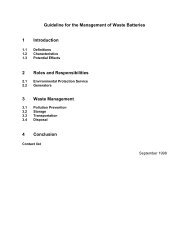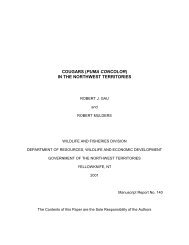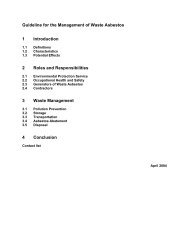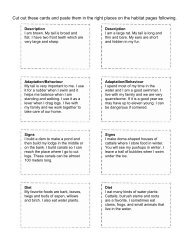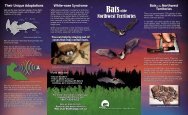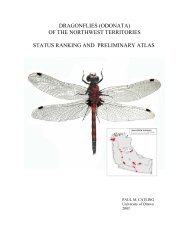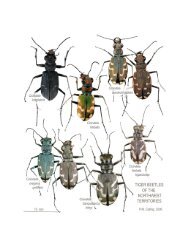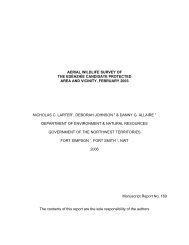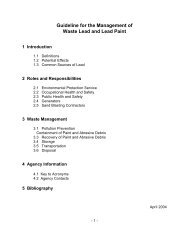Standard Operating Procedure (SOP) - Environment and Natural ...
Standard Operating Procedure (SOP) - Environment and Natural ...
Standard Operating Procedure (SOP) - Environment and Natural ...
- No tags were found...
You also want an ePaper? Increase the reach of your titles
YUMPU automatically turns print PDFs into web optimized ePapers that Google loves.
<strong>St<strong>and</strong>ard</strong> <strong>Operating</strong> <strong>Procedure</strong> (<strong>SOP</strong>)<br />
Capture, H<strong>and</strong>ling & Release of Bears<br />
Wildlife Care Committee Primary Author: Dr. Marc Cattet Version 2 - 2011<br />
• Culvert traps must be built in such a way that bears cannot bite or<br />
hook a tooth around parts of the trap.<br />
• Culvert traps must be prepared <strong>and</strong> set in well-shaded areas, <strong>and</strong><br />
access routes must be clearly marked to prevent persons from<br />
inadvertently encountering a bear in the vicinity of the trap.<br />
• Culvert traps should always be set with a clear line of sight to<br />
permit assessment from a safe distance.<br />
• Active traps must be inspected routinely at least once daily.<br />
Inspections should be more frequent if traps are set in close<br />
proximity to communities or campgrounds where they may attract<br />
the attention of curious people or pets. The likelihood of injury to<br />
trapped bears may increase with the duration of captivity.<br />
• Trapped bears should be anesthetized, examined, <strong>and</strong><br />
permanently identified with a unique number or alphanumeric<br />
code by tattoo, ear tag, or transponder.<br />
• Drugs should be administered to bears in culvert traps using a<br />
pole syringe (jab pole) or blowpipe.<br />
Dart pistols or rifles must not be used unless the dart velocity can be<br />
precisely controlled to ensure the dart impact occurs at low velocity,<br />
e.g., 20-25 m/sec required for penetration of skin by needle<br />
(MacPherson 1994).<br />
• Bears must be recovered from anesthesia before translocation.<br />
Adequate recovery can be determined by assessing if the animal is<br />
able to st<strong>and</strong> on all four legs. This may require temporarily moving<br />
the trap or transport container to a cool, quiet area where the bear<br />
can recover with minimal stress before translocation.<br />
• During translocation, bears must be protected from flying material<br />
(e.g., rocks, mud) <strong>and</strong> excessive jarring.<br />
This may require the construction <strong>and</strong> use of a transport container<br />
that can be secured in the back of a truck or slung beneath a<br />
helicopter. Alternatively, a culvert trap-trailer can be used provided<br />
the bear is shielded from flying debris <strong>and</strong> the trailer is fitted with<br />
strong springs <strong>and</strong> shocks.<br />
• Bears should not be held captive in a culvert trap or transport<br />
container longer than 24 hours.<br />
Captivity is extremely stressful to most wild animals. If a bear must<br />
be held captive for a prolonged period (e.g., 6-24 hours) to permit<br />
recovery from anesthesia or to transport to a release site, it must be<br />
provided water to prevent dehydration.<br />
4.1.2.3 Leg-Hold Snare<br />
Is: A technique that generally involves attracting bears to a bait site at<br />
which an Aldrich leg snare is set on an approaching trail or at the bait site<br />
(i.e., cubby set, pail set, etc.).<br />
12



